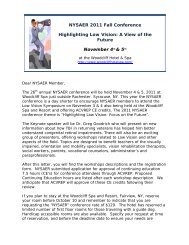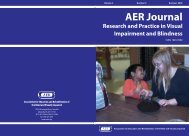Association for Education and Rehabilitation of the Blind - AER Online
Association for Education and Rehabilitation of the Blind - AER Online
Association for Education and Rehabilitation of the Blind - AER Online
You also want an ePaper? Increase the reach of your titles
YUMPU automatically turns print PDFs into web optimized ePapers that Google loves.
Vision, Posture, <strong>and</strong> Ageing<br />
down <strong>and</strong> bottom-up modes at some point in<br />
development, <strong>and</strong> Massion believes that <strong>the</strong> reorganization<br />
<strong>of</strong> postural control that occurs around <strong>the</strong><br />
age <strong>of</strong> 7 years is a last challenge to this process <strong>of</strong><br />
integration. O<strong>the</strong>r researchers have also found that<br />
this is a watershed age <strong>for</strong> development. Assiante<br />
<strong>and</strong> Amblard (1992) report a transition phase <strong>for</strong> <strong>the</strong><br />
use <strong>of</strong> peripheral vision in dynamic balance control<br />
around <strong>the</strong> age <strong>of</strong> 7, <strong>and</strong> <strong>the</strong>re is a transition phase<br />
around ages 7 to 8 <strong>for</strong> movement control generally<br />
(Nougier, Bard, Fleury, & Teasdale, 1998).<br />
Ultimately upright postural stability is behavioral as<br />
much as it is a state <strong>of</strong> readiness <strong>for</strong> action.<br />
In<strong>for</strong>mation from <strong>the</strong> somatosensory, vestibular, <strong>and</strong><br />
visual systems all lead to <strong>the</strong> establishment <strong>of</strong> <strong>the</strong><br />
‘‘behavioral vertical,’’ <strong>and</strong> uprightness is maintained<br />
by reference to it (Roberts, 1995). The behavioral<br />
vertical is a composite <strong>of</strong> all sensory in<strong>for</strong>mation, not<br />
just <strong>the</strong> gravity vertical measured by <strong>the</strong> vestibular<br />
apparatus, with <strong>the</strong> imperative <strong>of</strong> preserving <strong>the</strong><br />
integrity <strong>of</strong> <strong>the</strong> major sensory receptors in <strong>the</strong> head<br />
from hitting <strong>the</strong> ground.<br />
Age-Related Changes to<br />
Sensory Input<br />
According to Peterka (2002), healthy adults on a<br />
firm base <strong>of</strong> support <strong>and</strong> in well-lit conditions will rely<br />
on 70 percent somatosensory, 20 percent vestibular,<br />
<strong>and</strong> 10 percent visual input to maintain postural<br />
support. As <strong>the</strong> environment changes <strong>the</strong> individual<br />
can reweight his or her relative dependence on <strong>the</strong>se<br />
inputs. If <strong>the</strong> surface is unstable, <strong>the</strong> individual<br />
decreases his or her dependence on somatosensory<br />
input <strong>and</strong> will shift <strong>the</strong> weighting toward vestibular<br />
<strong>and</strong> visual cues. The functioning <strong>of</strong> this re-weighting<br />
‘‘can be likened to a proportional representation<br />
voting system, in which every single vote has an<br />
impact on <strong>the</strong> outcome but <strong>the</strong> strength <strong>of</strong> that impact<br />
depends on <strong>the</strong> total number <strong>of</strong> votes’’ (Day & Cole,<br />
2002, p. 2087).<br />
Simoneau, Leibowitz, Ulbrecht, Tyrrell, <strong>and</strong> Cavanagh<br />
(1992) studied <strong>the</strong> effect <strong>of</strong> vision <strong>and</strong> head<br />
posture in a group <strong>of</strong> older women <strong>and</strong> concluded<br />
that <strong>the</strong> somatosensory system contributed 58<br />
percent to postural stability <strong>and</strong> that <strong>the</strong> vestibular<br />
system contributed 12 percent, leaving 30 percent to<br />
be accounted <strong>for</strong> by visual input. Perrin, Je<strong>and</strong>el,<br />
Perrin, <strong>and</strong> Bene (1997) studied somatosensory <strong>and</strong><br />
visual inputs to postural control in healthy older<br />
44 | <strong>AER</strong> Journal:Research <strong>and</strong> Practice in Visual Impairment <strong>and</strong> <strong>Blind</strong>ness<br />
adults <strong>and</strong> found that nerve conduction speeds <strong>and</strong><br />
CNS integration slows with age. They found that<br />
older adults had difficulty adjusting <strong>the</strong>ir balance by<br />
movement around <strong>the</strong> ankles <strong>and</strong> shifted to a<br />
reliance on visual input, especially <strong>for</strong> dynamic<br />
balance control. Peripheral somatosensory sensation<br />
is <strong>the</strong> most important sensory subsystem in <strong>the</strong><br />
maintenance <strong>of</strong> st<strong>and</strong>ing balance, but with slower<br />
response times, older adults begin to reweight<br />
toward visual input.<br />
Lord <strong>and</strong> Menz (2000) found that visual impairment<br />
was strongly associated with increased<br />
instability when <strong>the</strong> subjects were st<strong>and</strong>ing on a<br />
compliant surface that reduced proprioceptive input<br />
from <strong>the</strong> ankles <strong>and</strong> feet. If visual impairment<br />
compromises <strong>the</strong> usefulness <strong>of</strong> <strong>the</strong> input from <strong>the</strong><br />
visual system, <strong>the</strong>n <strong>the</strong> individual is pushed closer to<br />
<strong>the</strong> limits <strong>of</strong> his or her ability to maintain postural<br />
integrity. This is particularly so if <strong>the</strong> supportive<br />
surface is compliant (e.g., lawn <strong>and</strong> gym mats),<br />
fur<strong>the</strong>r limiting <strong>the</strong> independence <strong>of</strong> older people with<br />
visual impairments.<br />
The development <strong>of</strong> postural stability is based on<br />
<strong>the</strong> maturation <strong>of</strong> <strong>the</strong> three sensory subsystems that<br />
subserve upright balance. Because <strong>of</strong> differing<br />
maturation rates <strong>and</strong> changing body proportions,<br />
young children have difficulty resolving conflicting<br />
in<strong>for</strong>mation from <strong>the</strong>se subsystems, but in adolescents<br />
15 to 16 years <strong>of</strong> age, all three subsystems are<br />
mature <strong>and</strong> <strong>the</strong>y should have <strong>the</strong> ability to solve<br />
intersensory conflict. This gives adults a large safety<br />
margin to ensure postural stability as <strong>the</strong>y move<br />
through <strong>the</strong> changing external world.<br />
With ageing <strong>and</strong> slower response times in <strong>the</strong><br />
nervous system, older adults begin to reweight<br />
toward visual input, but if visual ability declines, this<br />
pushes <strong>the</strong> older adult closer to <strong>the</strong> limits <strong>of</strong> his or<br />
her postural integrity <strong>and</strong> predisposes him or her to<br />
falls. Likewise, individuals with total or partial visual<br />
impairments are prone to falls, <strong>and</strong> <strong>the</strong>re is a higher<br />
risk <strong>of</strong> fall or instability-related injury in this population<br />
(Klein, Klein, Lee, & Cruickshanks, 1998).<br />
As bodily changes occur throughout <strong>the</strong> life span,<br />
<strong>the</strong> CNS must adapt <strong>and</strong> recalibrate its ability to<br />
maintain postural integrity. This integrity is not static<br />
but dynamic <strong>and</strong> is best conceived <strong>of</strong> as a perceptual<br />
motor skill (Reed, 1990). Interventions such as<br />
exercise <strong>and</strong> balance training are regularly used in<br />
rehabilitation settings to improve <strong>the</strong> postural integrity







